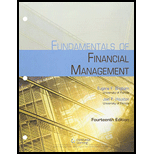
ALTERNATIVE DIVIDEND POLICIES In 2014, Keenan Company paid dividends totaling $3,600,000 on net income of $10.8 million. Note that 2014 was a normal year and that for the past 10 years, earnings have grown at a constant rate of 10%. However, in 2015, earnings are expected to jump to $14 4 million and the firm expects to have profitable investment opportunities of $8 4 million. It is predicted that Keenanwill not be able tomaintain the 2015 level of earnings growth because the high 2015 earnings level is attributable to an exceptionally profitable new product line introduced that year. After 2015, the company will return to its previous 10% growth rate. Keenan’s target capital structure is 40% debt and 60% equity.
- a. Calculate Keenan’s total dividends for 2015 assuming that it follows each of the following policies:
1. Its 2015 dividend payment is set to force dividends to grow at the long-run growth rate in earnings.
2. It continues the 2014 dividend payout ratio.
3. It uses a pure residual dividend policy (40% of the $8 4 million investment is financed with debt and 60% with common equity).
4. It employs a regular-dividend-plus-extras policy, with the regular dividend being based on the long-run growth rate and the extra dividend being set according to the residual dividend policy.
- b. Which of the preceding policies would you recommend? Restrict your choices to the ones listed but justify your answer.
- c. Assume that investors expect Keenan to pay total dividends of $9,000,000 in 2015 and to have the dividend grow at 10% after 2015. The stock’s total market value is $180 million. What is the company’s
cost of equity ? - d. What is Keenan’s long-run average
return on equity ? [Hint: g = Retention rate × ROE =(1 0 – Payout rate) (ROE).] - e. Does a 2015 dividend of $9,000,000 seem reasonable in view of your answers to parts c and d? If not, should the dividend be higher or lower? Explain your answer.
Trending nowThis is a popular solution!

Chapter 15 Solutions
Bundle: Fundamentals of Financial Management, 14th + MindTap Finance, 1 term (6 months) Printed Access Card
- Nikes annual balance sheet and income statement for 2022-2023 and 2024arrow_forwardWhat is the value at the end of year 3 of a perpetual stream of $70,000 semi-annual payments that begins at the end of year 7? The APR is 12% compounded quarterly.arrow_forwardFirm A must pay $258,000 to firm B in 10 years. The discount rate is 16.44 percent per year. What is the present value of the cash flow associated with this arrangement for firm A? -I got the answer of 56331.87773=56332 (rounded to the nearest dollar), but it says incorrect.arrow_forward
- Suppose you have two histograms: one where the mean equals the median, and one where the mean is different from the median. How would you expect the two histograms to differ.arrow_forward(a) The variables have been stripped of their names. Which one do you think is "household income" ?(b) Calculate the mean, median, and standard deviation of household income. Do these numbers fit with your expectations? (c) Suppose you have two histograms: one where the mean equals the median, and one where the mean is different from the median. How would you expect the two histograms to differ?arrow_forwardJanet Foster bought a computer and printer at Computerland. The printer had a $860 list price with a $100 trade discount and 210210 , n30n30 terms. The computer had a $4,020 list price with a 25% trade discount but no cash discount. On the computer, Computerland offered Janet the choice of (1) paying $150 per month for 17 months with the 18th payment paying the remainder of the balance or (2) paying 6% interest for 18 months in equal payments. Assume Janet could borrow the money for the printer at 6% to take advantage of the cash discount. How much would Janet save? Note: Use 360 days a year. Round your answer to the nearest cent.arrow_forward
- Don't used Ai solutionarrow_forwardConsider the following cash flows on two mutually exclusive projects for the Bahamas Recreation Corporation (BRC). Both projects require an annual return of 14 percent. New Submarine Deepwater Fishing Year Ride 0 -$875,000 1 330,000 2 480,000 3 440,000 -$1,650,000 890,000 730,000 590,000 a-1. Compute the IRR for both projects. (Do not round intermediate calculations and enter your answers as a percent rounded to 2 decimal places, e.g., 32.16.) Deepwater Fishing Submarine Ride 19.16 % 17.50% a-2. Based on the IRR, which project should you choose? Deepwater Fishing Submarine Ride b-1. Calculate the incremental IRR for the cash flows. (Do not round intermediate calculations and enter your answer as a percent rounded to 2 decimal places, e.g., 32.16.) Incremental IRR 14.96 % b-2. Based on the incremental IRR, which project should you choose? Submarine Ride Deepwater Fishingarrow_forwardWhat is the possibility that cases are not readily bounded but may have blurry definitions? How to address Robert Yin statement and how to resolve the ‘not readily bound’ case? Please help explain.arrow_forward
 Fundamentals Of Financial Management, Concise Edi...FinanceISBN:9781337902571Author:Eugene F. Brigham, Joel F. HoustonPublisher:Cengage Learning
Fundamentals Of Financial Management, Concise Edi...FinanceISBN:9781337902571Author:Eugene F. Brigham, Joel F. HoustonPublisher:Cengage Learning Intermediate Financial Management (MindTap Course...FinanceISBN:9781337395083Author:Eugene F. Brigham, Phillip R. DavesPublisher:Cengage Learning
Intermediate Financial Management (MindTap Course...FinanceISBN:9781337395083Author:Eugene F. Brigham, Phillip R. DavesPublisher:Cengage Learning


